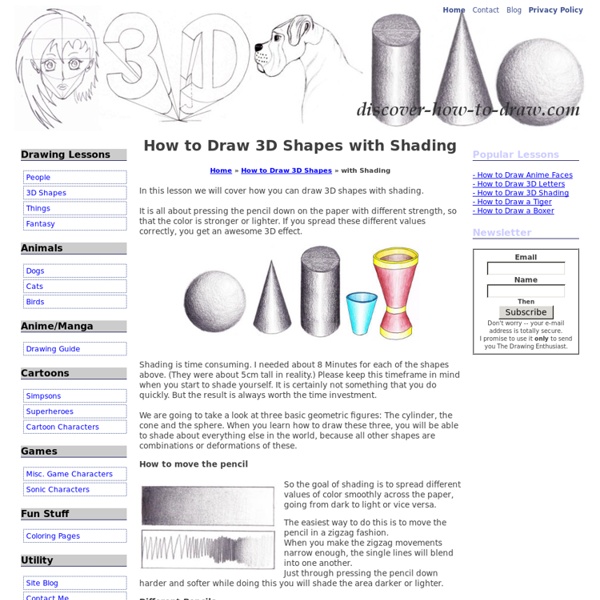Shading Techniques With Pencil | How To Draw... Pencil Portraits
Once you have mastered the basic pencil drawing techniques from the last tutorial, these can then be used to create different shading techniques within pencil drawings. This tutorial will guide you through the process of creating different shades and a shading guide in which you will be able to refer to throughout this tutorial. A shading guide when learning to draw is a useful tool to have, as you will be able to assess which shade is appropriate for different parts of the pencil portrait before executing it. In time, as you become more familiar with the different shades you can create, you will be able to ditch the shading guide and execute shading as though it is completely natural to you. When you were back at the process of choosing your art supplies, you would have made a decision on whether to purchase a set of drawing pencils in different grades, or just one single pencil in a versatile grade. Again, this is a personal preference, and different people prefer different things. 1.) .)
0624e71dd9e790f2a917b9ffdbdae6d2
PSG Art tutorial
2014 foreword added 2018 Is it possible to write a general tutorial on painting pretty pictures or is this art-thing too complex and magical to ever be understood, a thing for human intuition only? No human is alike, but we live in the same environment and train our brains together. I believe this creates certain shared structures which can be analysed and understood, at least on a sufficiently useful superficial level. Getting started from nowhere It has been claimed that you need to put ten thousand hours into a skill to "master" it, whatever that means. So, anyways. Self-critique ghost Sometimes, often, an image just feels wrong somehow. Fix that thing! On studies I seldom do studies, but when I do I notice improvement very quickly. To see the complete picture faster, and to give you something to hold on to, you can put down blobs and reference marks. End 2014/2018 Updates 2018 June25: Changed foreword (+ stuff above) to something I wrote mostly in 2014. Table of contents Licence Light stuff
Learn to Draw Animals
Print and enjoy our Learn to Draw Animals pages for kids of all ages. Kids can use our step by step illustrations to discover how to draw all sorts of animals and build up their skills and confidence in the process...plus they are just good fun! You could build up a whole folder of these printable pages for rainy days - teachers might even want to laminate them and keep them ready as a time-filler or reward. And of course many of them tie into classroom themes, too. We have over 80 of these animal drawing pages so you are sure to find one that appeals! By special request, save yourself a lot of clicking and grab all our learn to draw animals, birds, bugs and sea creatures in one easy download! Learn to draw this cute chimpanzee just by following the steps and copying carefully. Whether you are looking at African animals, primates or even Ancient Egyptian Gods, use our learn to draw a baboon guide to add some fun. Have you ever wanted to learn how to draw a badger? Kids love meerkats!
Basic Pencil Shading by Snigom on DeviantArt
4b0623fcf3f7e74c465df1463b7337ea
Block Stitch Afghan : the way I do it !!!!
.....what about two more pictures of my blanket to be???? Some of you asked me how the "dots" ( I call them "rice grains"!!!) can pop out in this way, so I thought it will be nice if I show you how this happens!!!! Happy about that??? Yes, I imagine so! Collect just few things : + hook + yarn in different colours + scissors + tapestry needle This is the chart (american crochet terminology), drawn by myself (!!!!!!) Your foundation chain will have these characteristics : chain 4, add as many as you like groups of "chain 3". Choose the colour you would love to start with and make a slip knot. Chain 20 stitches Chain 2 more (total : 22 stitches) and make a single crochet (or SC) in the 7th stitch from the hook (that is the previous stitch 16 on the foundation chain!) Now, chain 2 ... ... skip 2 stitches of the foundation chain and work 1 SC in the 3rd stitch (that is the previous 13 stitch of your foundation chain!) Again : chain 2, skip 2, SC in third stitch (previous #10!) Cut the yarn Row 1 : Row 2 :
Random Pets-Animals Tutorials by Hellobaby on DeviantArt
How to make an awesome pencil sketch of any photograph
To start with, you will need to go to your local art store to get the items that you don't already have. I am going to assume that you are like most people and don't have a single item except maybe a number 2 pencil. Oh, and you will need scissors and scotch tape in a few steps, but I assume that you have that stuff. Here is a list of what i recommend you get in order to successfully complete this instructable: Required supplies: -sketch pencils in different hardnesses: HB, 2B, 4B, 6B (and 8B optional) = $5 -a sketch pad that is 18" by 24" = $10 -1/2" drafting masking tape = $4-a pad of tracing paper 9" x 12" = $3-a good wad of kneaded eraser = $2-a "Tuff Stuff" eraser stick = $2-dry cleaning eraser pad = $4-a foxtail (aka drafting duster) = $3-assorted paper stumps for shading = $2-prismacolor pencil sharpener = $4-erasing shield = $1 Total required supplies: $40 Optional supplies, in order of importance: Total optional supplies: $57 Total recommended supplies: $97



